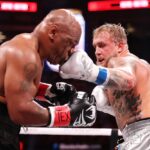A simple solution to fighting in hockey
“And still, with the brutal nature of the act and cases of CTE popping up like mushrooms, fighting should be allowed in hockey. It’s part of the game and it makes cheap shot artists think twice about taking a run at any of the more skilled players. Banning it is out of the question and you’d likely see two-hand touch implemented in football before you’ll see fighting in hockey go away.”
Concussion season and hockey season kicked off at the same time a few weeks ago, and while the NHL has skated on, the concussion discussion fell off faster than the Colorado Rockies in May.
Still salivating over the juicy topic of head injuries in football, talk shows seized upon fighting in the NHL as the next hot button issue. Why should the league allow fighting when we now know so much about the effects of head trauma on the brain? Radio hosts were going to find out. And along the way, they would pontificate on the evils of fighting in a professional sport.
But while the Frontline documentary League of Denial thrust sports related head trauma back in the spotlight for a few hours, the outcry over the danger of hockey fights died out quickly. Hosts who were pounding their desks for the ban on fighting in the NHL, moved on to other topics once hockey settled in for the long haul. And it’s too bad. Fighting in hockey has become the silent assailant in sports related brain trauma as more and more “enforcers” have died from conditions relating to it. And if traced properly, those deaths have a deducible link to fighting.
Derek Boogaard died of an accidental painkiller overdose back in 2011 and the autopsy revealed he was also suffering from chronic traumatic encephalopathy (CTE). Boogaard was a typical “enforcer” in the league and the CTE and painkiller addiction he acquired is generally linked to the amount of fighting he did while playing. His family apparently agreed. They filed a wrongful death lawsuit against the NHL last May alleging the league had no regard for Boogaard’s health in prescribing him pain killers and allowing him to fill his role as enforcer even after it was clear he had a substance abuse problem and had suffered multiple concussions. Boogaard died while in a league mandated substance abuse program, but even if he got clean, the CTE may have gotten him soon after. It’s a sad end to someone’s life who made his money by knocking heads with the other team’s hired goons.
Unfortunately for the future Derek Boorgaard’s, fighting in hockey is not going anywhere. Because – and as callous as this may sound – there is simply nothing like a hockey fight. If you’re in the arena when one starts up, the place goes wild and you can feel the adrenaline levels of the patrons rise as the two players begin their barbaric dance. While at home, I still sit straight up and say “FIGHT!” when the gloves are dropped. Every day I try and shield my kids from violent television, and yet there I am, yelling “FIGHT” when two grown men on ice skates start throwing punches. Why? Because we love it. We wish most of our daily troubles could be solved this way: drop the gloves, pound on each other and when it’s over, skate off to your respective box. Hockey is graceful and elegant, but it can also be brutal – and fighting is a natural extension of the sport.
And still, with the brutal nature of the act and cases of CTE popping up like mushrooms, fighting should be allowed in hockey. It’s part of the game and it makes cheap shot artists think twice about taking a run at any of the more skilled players. Banning it is out of the question and you’d likely see two-hand touch implemented in football before you’ll see fighting in hockey go away. But you can limit it and probably phase it out while not having to ban it, because there is a solution that will keep all concerned happy.
Fighting is alway a matching penalty and after the players skate to their boxes, play resumes five on five. This would have to change immediately. After an altercation where two players square off and engage each other in a way that would draw a fighting major, they would immediately be sent to the box for five minutes. Only now, play would resume with four on four for the duration of the fighting penalty.
If you choose to fight, you have now reduced the number of players on the ice while you sit for five minutes. The more skilled teams will delight in this because they will have more room to maneuver. Less skilled teams will think twice about fighting because they won’t want to give the other team an advantage. Toss any more penalties into the mix and you can be looking at a four on three situation which is certain death for a lot of teams. With very skilled squads like the Blackhawks, Penguins or Red Wings getting four on four opportunities throughout a game, the net result would be a lot more goals. And more excitement for the fans. Less agile teams will think twice about fighting and the number of altercations will decrease significantly.
But there will come a time that fighting is necessary. And when it happens, the above rules can be implemented, but it may not be enough to keep players from going at it. So if a player fights, he gets what is essentially a “red card” and has to sit out the next game no matter what. Granted a lot of the guys doing the fighting aren’t exactly the high volume goal scorers, but no one wants to sit out a game and the coaches don’t want to have to fill the roster spot every other night. If a player fights, it’s fine. The other guy probably deserved it. But there’s a one game suspension waiting for them once they finish up. Even the biggest lunkhead on the ice will give pause to drop the gloves when that is his end result.
This is a perfect solution for the NHL because it makes it look like they are addressing the issue while still allowing it to go on. Even if the league truly doesn’t care about the safety of its players, this allows for the age old tradition of fighting, without all of the nasty fallout down the line. Because they can say “well, we told you not to fight”, the NHL will at least look they are doing something. Fans would be happy – even though there would be less fisticuffs – and critics would call it a bold move by the league in bucking tradition. Fighting is necessary in hockey and it shouldn’t be fully removed, but with safety of the players becoming more and more of a priority, there are simple ways it can be curtailed and eventually phased out.
And when talk radio takes up the cause again for another two days next year, hopefully a real solution like this can be discussed and cooler heads will prevail instead of the usual hot air.





